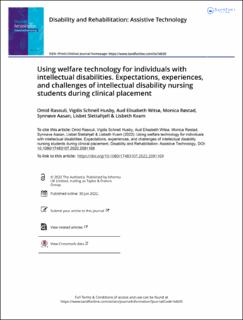| dc.contributor.author | Rasouli, Omid | |
| dc.contributor.author | Schnell Husby, Vigdis | |
| dc.contributor.author | Witsø, Aud Elisabeth | |
| dc.contributor.author | Røstad, Monica | |
| dc.contributor.author | Aasan, Synnøve | |
| dc.contributor.author | Slettahjell, Lisbet | |
| dc.contributor.author | Kvam, Lisbeth | |
| dc.date.accessioned | 2022-11-15T10:29:55Z | |
| dc.date.available | 2022-11-15T10:29:55Z | |
| dc.date.created | 2022-06-21T19:51:52Z | |
| dc.date.issued | 2022 | |
| dc.identifier.citation | Disability and Rehabilitation: Assistive Technology. 2022, . | en_US |
| dc.identifier.issn | 1748-3107 | |
| dc.identifier.uri | https://hdl.handle.net/11250/3031872 | |
| dc.description.abstract | Purpose: Little is known about how welfare technology (WT) is used in welfare services for people with intellectual disabilities. This study aimed to explore expectations, experiences, and challenges concerning the use of WT for people with intellectual disabilities among bachelor-level intellectual disability nursing students during clinical placement. Materials and Methods: A written reflection assignment (four open questions about using WT) was collected from 100 intellectual disability nursing students (30 males, 70 females). Four focus group discussions were also performed with 13 intellectual disability nursing students before and after their clinical placements. Results: Analysis of the assignments showed that “security and safety” technology was the most frequently used WT category for people with intellectual disabilities in the clinical placement settings in municipal welfare and day services. The students reported “Compensation & wellness” technology as the top category to promote the quality of services for people with intellectual disabilities. However, people with intellectual disabilities mostly used WT for “Social contact.” Students were mainly positive towards WT and believed it could improve the service quality and the everyday lives of this group. However, the students requested to learn more about WT and ethical issues regarding WT before clinical placement. Additionally, they experienced a lack of knowledge, focus, and awareness about technology in services for this group. Conclusion: The findings suggest that although intellectual disability nursing students have a positive attitude toward using WT for people with intellectual disabilities, they require more skill training and ethical knowledge before entering clinical practice. | en_US |
| dc.description.abstract | Using welfare technology for individuals with intellectual disabilities. Expectations, experiences, and challenges of intellectual disability nursing students during clinical placement | en_US |
| dc.language.iso | eng | en_US |
| dc.publisher | Informa UK Limited | en_US |
| dc.rights | Attribution-NonCommercial-NoDerivatives 4.0 Internasjonal | * |
| dc.rights.uri | http://creativecommons.org/licenses/by-nc-nd/4.0/deed.no | * |
| dc.title | Using welfare technology for individuals with intellectual disabilities. Expectations, experiences, and challenges of intellectual disability nursing students during clinical placement | en_US |
| dc.title.alternative | Using welfare technology for individuals with intellectual disabilities. Expectations, experiences, and challenges of intellectual disability nursing students during clinical placement | en_US |
| dc.type | Peer reviewed | en_US |
| dc.type | Journal article | en_US |
| dc.description.version | publishedVersion | en_US |
| dc.source.pagenumber | 7 | en_US |
| dc.source.journal | Disability and Rehabilitation: Assistive Technology | en_US |
| dc.identifier.doi | 10.1080/17483107.2022.2091169 | |
| dc.identifier.cristin | 2034037 | |
| cristin.ispublished | true | |
| cristin.fulltext | original | |
| cristin.qualitycode | 1 | |

